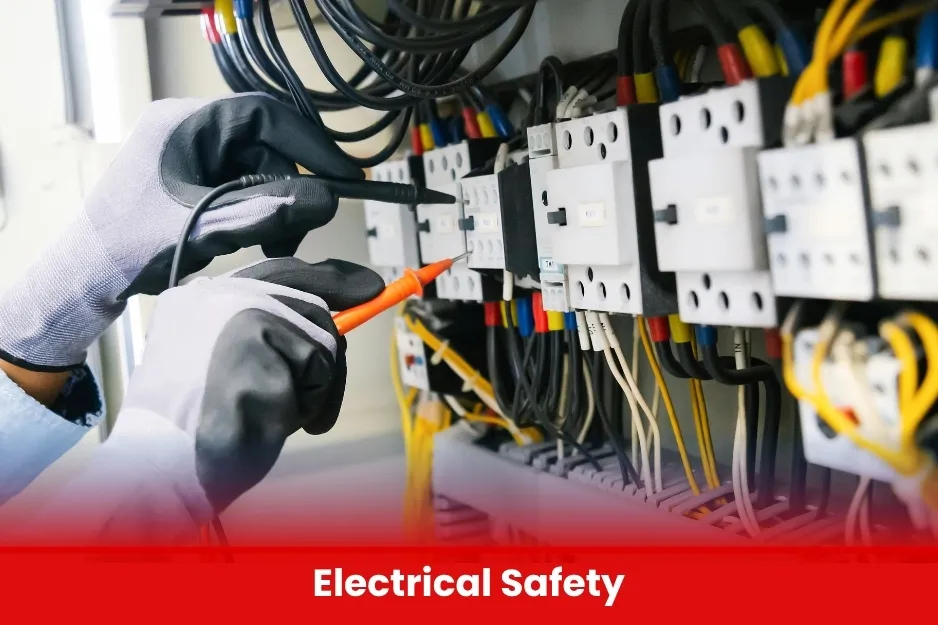Electrical safety
At BURAAQ UK, ensuring the safety of everyone working with or around electrical systems is a top priority. Electrical Safety involves understanding and managing the risks associated with electricity to prevent accidents such as electric shocks, burns, fires, and explosions.Electricity powers our modern industries and workplaces, but it can also be hazardous if not handled correctly. Faulty wiring, improper use of equipment, or lack of awareness can lead to serious injuries or even fatalities.

Aim of Electrical safety
The aim of Electrical Safety at BURAAQ UK is to prevent electrical accidents and injuries by promoting safe work practices, hazard awareness, and compliance with UK electrical safety standards.We strive to equip individuals and organisations with the knowledge and skills needed to identify electrical risks, use equipment safely, and respond effectively to emergencies, ensuring a safe working environment for all.
Course Overview
Electrical safety
Minimum Age:
- Participants must be 18 years or older.
Educational Background:
- Basic understanding of electrical concepts or technical education is preferred but not mandatory.
- Suitable for individuals with backgrounds in engineering, electrical trades, maintenance, or safety roles.
Work Experience:
- Beneficial for individuals working in or intending to work in roles involving electrical equipment, installation, or maintenance.
- Beginners are welcome, especially if enrolled in foundational courses.
| Course Code | Curriculum Title | Credit | DLH |
|---|---|---|---|
| BUK1594-1 | Introduction to Electrical Safety | 3 | 15 |
| BUK1594-2 | Basics of Electricity | 3 | 15 |
| BUK1594-3 | Electrical Hazards and Their Effects | 3 | 15 |
| BUK1594-4 | Personal Protective Equipment (PPE) | 3 | 15 |
| BUK1594-5 | Electrical Inspections and Risk Assessments | 3 | 15 |
| BUK1594-6 | UK Regulations and Standards | 3 | 15 |
Module 1: Introduction to Electrical Safety
- What is electrical safety?
- Common electrical hazards in the workplace
- Importance of electrical safety in various industries
Module 2: Basics of Electricity
- Understanding voltage, current, and resistance
- Types of electrical systems (AC/DC)
- Overview of electrical components (wires, breakers, fuses)
Module 3: Electrical Hazards and Their Effects
- Electric shock, arc flash, arc blast, and burns
- Causes of electrical accidents
- Real-life case studies and incident analysis
Module 4: Safe Work Practices
- Lockout/Tagout (LOTO) procedures
- Use of insulated tools and protective barriers
- Safe use of extension cords, outlets, and portable devices
Module 5: Personal Protective Equipment (PPE)
- Types of PPE used in electrical work
- Arc-rated clothing and gloves
- Selection, use, and maintenance of PPE
Module 6: Electrical Inspections and Risk Assessments
- How to perform a basic electrical inspection
- Identifying faulty equipment and wiring
- Reporting and documenting electrical hazards
Module 7: UK Regulations and Standards
- Overview of UK legislation (e.g. Electricity at Work Regulations 1989)
- HSE (Health and Safety Executive) guidance
- Employer and employee responsibilities
Module 8: Emergency Response and First Aid
- Responding to electrical accidents and fires
- Electrical isolation and rescue techniques
- First aid for electric shock and burns
- Electricians, technicians, and maintenance staff
- Engineers involved in electrical design, installation, or supervision
- HSE officers and safety supervisors responsible for workplace safety
- Supervisors and managers overseeing electrical work
- Trainees, apprentices, or students in technical and vocational fields
- Any personnel working in environments where electrical hazards may exist
- All Modules within this qualification are assessed internally by the approved training Centre and externally verified by BURRAQ UK. The program uses a criterion-referenced assessment approach to ensure that learners successfully meet all required learning outcomes.
- A Pass in any unit is granted only when the learner submits valid, reliable, and authentic evidence that demonstrates achievement of the assessment criteria. The Assessor is responsible for reviewing this evidence and confirming that the learner has attained the expected standard.
